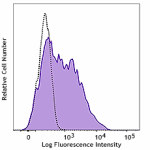- Clone
- W17200C (See other available formats)
- Regulatory Status
- RUO
- Other Names
- B-Lymphocyte activation antigen B7.1, CD80, Ly53, TSA1, CD28 ligand (CD28L), MIC17
- Isotype
- Rat IgG2a, κ
- Ave. Rating
- Submit a Review
- Product Citations
- publications

-

LPS-stimulated (3 days) C57BL/6 mouse splenocytes were stained with anti-mouse/human CD45R/B220 (clone RA3-6B2) Alexa Fluor® 647 and anti-mouse CD80 (clone W17200C) PE (left) or rat IgG2a, κ PE isotype control (right).
| Cat # | Size | Price | Quantity Check Availability | Save | ||
|---|---|---|---|---|---|---|
| 600055 | 25 µg | $177 | ||||
| 600056 | 100 µg | $384 | ||||
The B7 family of proteins are structurally related, cell membrane-associated molecules that regulate immune responses by delivering costimulatory or coinhibitory signals via their ligands. So far, eight family members have been identified, including B7.1 (CD80), B7.2, B7-H1, B7-H2, B7-H4, B7-H6, PD-L1, and PD-L2. These proteins are mainly expressed by activated antigen presenting cells (APCs) and when paired with either CD28 or CTLA-4 on a T lymphocyte, they induce an increase or decrease in the downstream signaling activity of the MHC-TCR interaction between APCs and T cells. B7.1 has been shown to bind both CTLA-4 and CD28. However, it has a 20-fold higher affinity to CTLA-4 than to CD28. Despite their structural similarities, the individual contribution of B7.1 and B7.2 to the development of pathogenic T cells in autoimmune diseases and protective T cells in infectious diseases is markedly distinct. Besides regulating T cell immune responses, B7 also plays a role in anti-tumor immunity. This is confirmed by demostrating that cytotoxic T cells were able to eradicate tumor cells transfected with B7.1 and B7.2. After activation, follicular lymphoma was shown to upregulate B7.1 and other costimulatory and adhesion molecules, therefore increasing APC activity and amplifying primed T cell responses. Homozygous null B7.1/B7.2 mice fail to generate antigen specific IgG1 and IgG2a responses, suggesting that B7 proteins are important in Ig immune responses. Mouse and human B7.1 share 44% amino acid identity.
Product DetailsProduct Details
- Verified Reactivity
- Mouse
- Antibody Type
- Monoclonal
- Host Species
- Rat
- Immunogen
- Recombinant mouse B7.1 (CD80)-Fc Chimera
- Formulation
- Phosphate-buffered solution, pH 7.2, containing 0.09% sodium azide
- Preparation
- The antibody was purified by affinity chromatography and conjugated with PE under optimal conditions.
- Concentration
- 0.2 mg/mL
- Storage & Handling
- The antibody solution should be stored undiluted between 2°C and 8°C, and protected from prolonged exposure to light. Do not freeze.
- Application
-
FC - Quality tested
- Recommended Usage
-
Each lot of this antibody is quality control tested by immunofluorescent staining with flow cytometric analysis. For flow cytometric staining, the suggested use of this reagent is ≤ 0.5 µg per million cells in 100 µL volume. It is recommended that the reagent be titrated for optimal performance for each application.
- Excitation Laser
-
Blue Laser (488 nm)
Green Laser (532 nm)/Yellow-Green Laser (561 nm)
Antigen Details
- Structure
- Homodimer
- Distribution
-
Activated B cells, monocytes, macrophages, dendritic cells
- Function
- Plays a role in T cell activation; CD80 and CD86 play an important role in T cell priming
- Interaction
- T cells
- Ligand/Receptor
- CD28, CTLA-4
- Cell Type
- B cells, Dendritic cells, Macrophages, T cells, Tregs
- Biology Area
- Cell Biology, Costimulatory Molecules, Immunology, Neuroscience, Neuroscience Cell Markers
- Molecular Family
- CD Molecules, Immune Checkpoint Receptors
- Antigen References
-
- Freeman GJ, et al. 1993. Science. 262:909-11.
- Azuma M, et al. 1993. Nature. 366:76-9.
- Gimmi CD, et al. 1991. Proc Natl Acad Sci USA. 88:6575-9.
- Linsley PS, et al. 1991. J Exp Med. 173:721-30.
- Greaves P and Gribben JG. 2013. Blood. 121: 734-44.
- Czuczman MS, et al. 2005. J Clin Oncol. 23:4390-8.
- Gene ID
- 12519 View all products for this Gene ID
- UniProt
- View information about CD80 on UniProt.org
Related FAQs
- What type of PE do you use in your conjugates?
- We use R-PE in our conjugates.
Other Formats
View All CD80 Reagents Request Custom Conjugation| Description | Clone | Applications |
|---|---|---|
| Ultra-LEAF™ Purified anti-mouse CD80 | W17200C | Block,FC |
| PE anti-mouse CD80 Antibody | W17200C | FC |
Compare Data Across All Formats
This data display is provided for general comparisons between formats.
Your actual data may vary due to variations in samples, target cells, instruments and their settings, staining conditions, and other factors.
If you need assistance with selecting the best format contact our expert technical support team.
-
Ultra-LEAF™ Purified anti-mouse CD80

Biotinylated recombinant mouse CTLA-4-Fc Chimera (Cat. No. 7... 
C57BL/6 mouse splenocytes were stimulated with LPS for 3 day... -
PE anti-mouse CD80 Antibody

LPS-stimulated (3 days) C57BL/6 mouse splenocytes were stain...

 Login/Register
Login/Register 













Follow Us